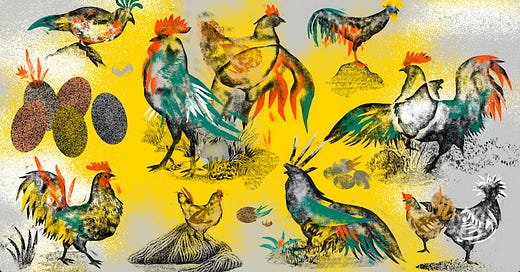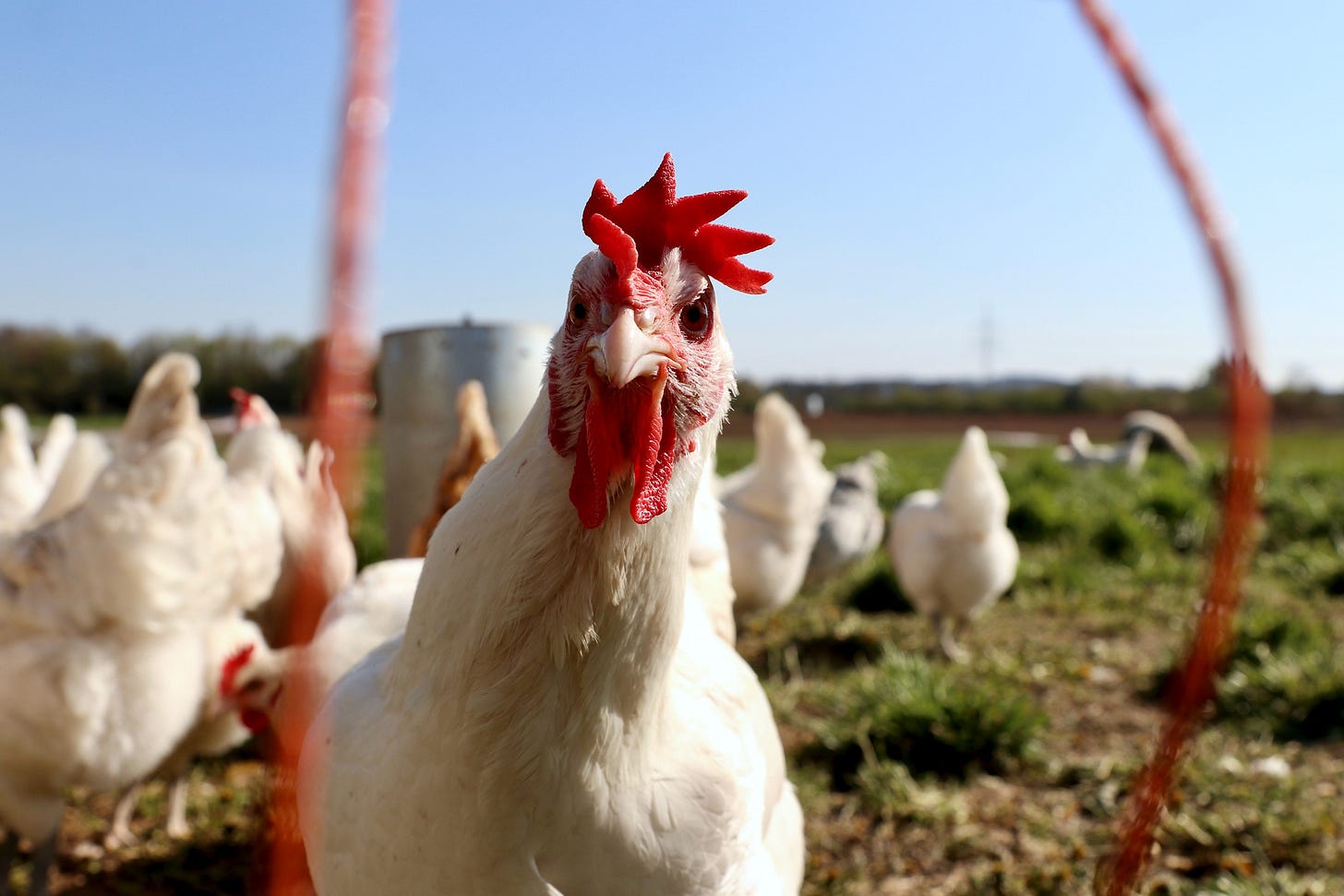My last published story of 2023 appeared in late December in Noema: an essay exploring the ethics, environmental and otherwise, of the chicken industry, and one Arkansas company in particular. Maybe, I concluded, what we need is not just a new form of poultry farming but a complete revolution in how we relate to meat.
I hope you’ll read the essay. I figured its publication was a good chance, too, to re-run this old Southlands on chickens and their place in the South.
Here is a short list of famous Southerners who lent their name and likeness to fried-chicken joints in the late 1960s: gospel singer Mahalia Jackson, Grand Ole Opry comedian Minnie Pearl, country singers Eddy Arnold and Little Jimmie Dickins (separate restaurants), and both the Queen and the Godfather of Soul, Aretha Franklin and James Brown.
You can blame Kentucky Fried Chicken for the sudden rush. Launched as a single Shell gas station serving slow pan-fried chicken legs, by 1966, when the brand went public, it had grown into the country’s largest commercial food-service operation. Only the military served more food. Founder Harland Sanders—not a Army colonel, just the recipient of a peculiar Kentucky gubernatorial honorarium—had already sold his stake, though he still served as the dapper, string-tied public face of the company, helping cement the image of finger-lickin’ chicken as a particularly Southern food.
The chicken is really a global creature, originating in Asia before spreading, well, pretty much everywhere. Genetic studies suggest this bird beat Europeans to the Americas, thanks to Polynesian sailors. By the time white settlers spread across North America in the 1800s and early 1900s, nearly every farmer in the U.S. had a small flock, supplying their own meat and eggs. For the rest of the country, though, chicken remained something of a luxury.
Fried chicken probably does have Southern bona fides. But, as John T. Edge noted in Fried Chicken: An American Story, tracing the dish’s history is a “frustrating exercise.” Cooking in deep oil is a West African tradition, and food in the South was often made by enslaved Africans or the enslaved descendants of Africans. Beyond that clear fact, the story grows murky—though it’s clear enough that a white faux-colonel is an ironic and unfortunate figurehead for this dish.
Sanders did not seem to care for the mass-produced food shilled by his new corporate overlords, which he deemed “nothing more than a friend doughball wrapped around some chicken.” In this way, perhaps, his story does emblemize the chicken story: the explosion of chicken as an accessible food is very much tied to the dubious ingenuity of capitalism. And this story, too, is tied to the South.
Modern chicken farming was pioneered far to the northeast, on the Delmarva Peninsula, where by the late 1920s meat chickens—or “broilers,” to use the industry term—were being raised by the thousands inside sheds. These were tough years for Southern farmers, and by the 1930s in in places where rugged terrain made farming row crops difficult—northeastern Georgia and the Ozarks in northwestern Arkansas, especially—locals decided to give this new technique a shot.
As chicken farming took off in Arkansas, a man named John W. Tyson started hauling his broilers north to sell in Kansas City and Chicago. Over the years, Tyson expanded: his empire included a hatchery and a feed mill, and then, by the late 1950s, a plant where chickens could be butchered. Tyson had become “vertically integrated,” in other words, controlling every step of the chicken supply chain except the actual farming, for which he offered contracts to other Arkansans. By the 1960s, as the Southern chicken chains took off, ninety percent of U.S. “broilers” were produced on vertically integrated farms.
Tyson, meanwhile, was surging towards its superlative: it’s now the world’s largest chicken producer (and the second-largest producer of meat in general). Today, Arkansas grows more broilers than any other state; down back roads in the Ozarks, the roofs of the long, thin sheds glisten under the sun. Inside, tens of thousands of chickens are cramped, with less than a square foot apiece of living space.
These days, local chicken farmers—in Arkansas, as everywhere—may be better thought of as “babysitters,” as I put it in a recent article for The New Republic, who feed “corporate-owned grain to corporate-owned chickens, which, once they grow big enough, will be trucked to corporate-owned slaughterhouses, sliced apart, wrapped in plastic, and stamped with corporate logos.”
This system has made chicken cheap and abundant; at some point in recent years, the bird became the world’s most-consumed protein. Besides this outcome, though, it’s hard to see the virtues of this system, even for Arkansas. Jobs in the processing plants are poorly paid, and conditions are horrid. Covid worsened the problem: Even after hundreds of workers contracted the virus, Tyson’s processing plants in Springdale remained open. The “growers”—the chicken babysitters, that is—aren’t particularly well served, either; the contracts are notoriously exploitative. Nonetheless, Tyson so dominates the local economy that they’ve essentially captured the local government. The town’s mayor consulted with Tyson before appearing on CNN to discuss the Covid outbreak.
Vertically integrated chicken farming is not great for the rest of the world, either. My story for The New Republic focused on how these kinds of farms are a grave pandemic risk, though that’s just the tip of the iceberg. Modern chickens have been bred to grow so fast that they barely develop an immune system. Instead, they have to be pumped full of antibiotics, which could undercut the effectiveness of human medicine.
The chickens don’t even make for great food. Fast-growing chickens are prone to “woody breast syndrome,” in which as much as ten percent of the meat becomes tough and knotty. When Edge wrote Fried Chicken, he noted that the “most intriguing fried chicken dishes seemed to be served restaurants where the cooks monkey the most with the birds.” You’ve got to, given the strangeness of the modern bird.
Chicken tourism
If you travel to Springdale, where Tyson was founded and remains headquartered, you can visit the Poultry Industry Historic District. Perhaps more fun, though, is road-tripping in search of great fried chicken. (My reporting on this bird has changed the way I eat, but I retain a soft spot, I admit.) Here in New Orleans, the can’t-miss spot is Willie Mae’s Scotch House. Where else should Southern travelers visit? Leave your recommendations in the comments.
Further reading
John T. Edge’s Fried Chicken documents a chicken road trip—not just across the South, but all of the U.S., and offers recipes to boot. If you’re more curious about the dark arts of modern chicken farming, then Maryn McKenna’s Big Chicken is the book for you. Or if you want an escape route toward a healthier relationship with poultry, consider pre-ordering Tove Danovitch’s Under the Henfluence: Inside the World of Backyard Chickens and the People Who Love Them.






